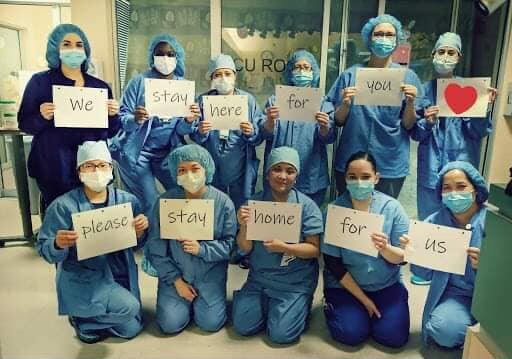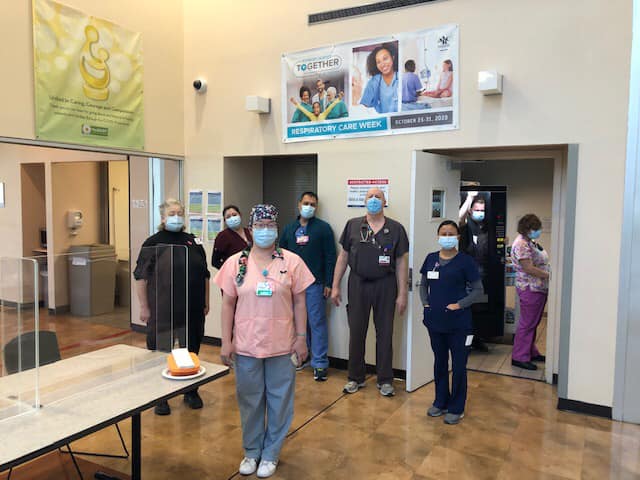Main story: County reverts back to most restrictive tier as cases rise
Gov. Newsom issues order effective Nov. 17 citing concerns of a COVID-19 hospitalizations surge
Published in the November 25 – December 8, 2020 issue of Gilroy Life

Photo courtesy St. Louise Hospital — ICU nurses at St. Louise Regional Hospital pose with a message during the beginning of the global pandemic. Santa Clara County is back in the most restrictive tier as COVID-19 cases are surging.
By Marty Cheek
Santa Clara County’s public health officials in mid-November urged residents to cancel holiday travel plans and exercise caution in interactions outside of their immediate household as COVID-19 cases and hospitalizations rise.
Citing concerns regarding a sudden surge in COVID-19 cases and hospitalizations throughout California, Gov. Gavin Newsom gave the order to bring 41 of the state’s 58 counties, including Santa Clara County, to the most restrictive purple tier starting Nov. 17. This is up from 13 counties the previous week and represents 94 percent of the state’s population. Most counties that did not move to the most restrictive tier moved into the red “substantial” risk tier.
As of Friday, Nov. 20, the county reported 2,068 cases of Gilroy residents confirmed to have COVID-19, nearly 4 percent of the city’s population. Morgan Hill has 861 confirmed cases, about 2 percent of the city’s population.
The state is hitting an “emergency brake” on economic activity in light of an unprecedented spike in COVID-19 cases statewide, Newsom said in a statement.
“We are sounding the alarm,” he said. “California is experiencing the fastest increase in cases we have seen yet — faster than what we experienced at the outset of the pandemic or even this summer. The spread of COVID-19, if left unchecked, could quickly overwhelm our health care system and lead to catastrophic outcomes.”
Under the state’s blueprint for COVID-19, the purple tier indicates that the risk of community transmission in the county is widespread. Impacts include the closure of indoor dining, which was already planned in Santa Clara County for Nov. 17, as well as the closure of all indoor activities associated with gyms, museums, zoos and aquariums, places of worship, and movie theaters. Shopping malls and all retail establishments must reduce to a maximum of 25 percent capacity.
The November surge in coronavirus cases promoted the more stringent restrictions across the state. California’s positivity rate is 4.6 percent now, up from 3 percent on Oct. 29. Newsom encouraged residents not to be “misled” by that state having a lower testing positivity rate than the national rate of 9.8 percent. “We don’t compare ourselves” to the numbers across the entire country, he said.

Photo courtesy St. Louise Regional Hospital Respiratory care practitioners at St. Louise Regional Hospital during Respiratory Care Practitioners Week in late October
“Today’s announcement from the state reflects that we appear to be heading into the worst phase of the pandemic to date,” said Santa Clara County Health Officer Dr. Sara Cody in a Nov. 16 press release. “Rapidly rising cases and hospitalizations should serve as a wake-up call for our entire community. We ask every resident to do everything they can to slow the spread of transmission in our community, protect our most vulnerable residents, and save lives.”
 Daily cases have doubled during a ten day period of time in early November in California, which is the fastest increase the state has seen since the beginning of the pandemic. Given the alarming rise in cases and hospitalizations, officials with the County of Santa Clara strongly urge residents to refrain from all travel, including over the upcoming Thanksgiving holiday, to gather with persons outside of their household only outdoors, and to limit interactions with persons outside of their immediate household.
Daily cases have doubled during a ten day period of time in early November in California, which is the fastest increase the state has seen since the beginning of the pandemic. Given the alarming rise in cases and hospitalizations, officials with the County of Santa Clara strongly urge residents to refrain from all travel, including over the upcoming Thanksgiving holiday, to gather with persons outside of their household only outdoors, and to limit interactions with persons outside of their immediate household.
A sharp uptick in reported COVID-19 cases Nov. 8 indicated community spread of the virus has increased, and Santa Clara County officials are urging the public to adhere to social distancing, use of face coverings, and other safety measures to help keep the community healthy and the county in its current “moderate” risk-level category.
There were 358 new COVID-19 cases reported Nov. 8, which is second only to the record 385 new cases reported July 15. Nearly all these cases are from test samples collected in the past week, about half in the past three days. The seven-day average of new cases the first week of November was between 131 and 139, accelerating after a slow climb that started in mid-October. In addition, the number of COVID-19 hospitalizations went up by nearly 10 percent.
“This surge in COVID-19 cases is not what we want to see going into the fall and winter,” Cody said. “New cases and resulting hospitalizations are increasing locally, regionally, as well as statewide and across the country and the world. These trends serve as a stark reminder that COVID-19 is all around us. Each and every one of us needs to redouble our efforts to keep our community safe.”
 Cooler temperatures and inclement weather that come with fall and winter mean people will be inclined to engage in more indoor activities, which are riskier than outdoor activities. Indoor dining, gathering in private homes with people outside of one’s household, and becoming complacent with “pandemic fatigue,” all elevate the risk of COVID-19 transmission.
Cooler temperatures and inclement weather that come with fall and winter mean people will be inclined to engage in more indoor activities, which are riskier than outdoor activities. Indoor dining, gathering in private homes with people outside of one’s household, and becoming complacent with “pandemic fatigue,” all elevate the risk of COVID-19 transmission.
Board of Supervisors President Cindy Chavez said it is imperative that both the community and businesses that are enjoying increased opportunities since the county moved into the state’s orange tier Oct. 13 be especially vigilant about adherence to mandatory social distancing protocols.
“Everyone appreciates the additional options that come from being in a less-restrictive tier,” Chavez said in a press release. “But we all need to be mindful that being in that tier doesn’t mean some activities do not come with certain risk, and that risk is greatly magnified if businesses and customers do not follow the rules in place to help keep them safe.”
 Before visiting any business, customers should know their commitment to COVID-19 safety protocols. Every business in the county is required to have a revised social distancing protocol on file with the county and the public is encouraged to review this in advance at www.sdp.sccgov.org/.
Before visiting any business, customers should know their commitment to COVID-19 safety protocols. Every business in the county is required to have a revised social distancing protocol on file with the county and the public is encouraged to review this in advance at www.sdp.sccgov.org/.
The County of Santa Clara Business and Compliance Enforcement Team has been responding to complaints of non-compliance for more than two months. The team is ramping up enforcement efforts to crack down on the businesses that willfully ignore educational outreach and continue to flout COVID-19 prevention mandates.
The enforcement — which can include fines and orders to cease operations — typically only come after educational efforts fail to yield results. Out of 1,658 business violation complaints received from Aug. 30 to Oct. 26, 1,088 were resolved through county contact and advisement regarding how the business can better operate within the realm of rules that keep staff and customers safe. By far the most complaints received involve the food service industry, and indoor dining continues to be one of the highest-risk activities currently allowed due to the fact patrons must remove their face covering to eat.
“Most businesses we contact are very interested in doing their part to keep themselves and the community healthy,” said County Counsel James R. Williams. “They readily accept their responsibility and operate accordingly. However, we cannot ignore those that operate in an unsafe manner. These are not optional guidelines; they are mandatory measures to protect our entire community.”
Entities that are not following safety protocols should be reported at www.sccCOVIDconcerns.org. The county’s enforcement team evaluates every concern that is received. All information is valuable and provides insight into potential safety issues. Formal enforcement is used for serious, repeat and willful violations and typically only after a business has refused to comply after being given an opportunity to do so.
The county has significant authority to enforce the health order. Fines start at $250 and increase to $5,000 for each violation and may double for multi-day violations. If there is a remedy to cure the violation, a grace period of 24 to 72 hours may be granted during which corrective action by the business will annul the fine.
The county may also pursue legal action to halt prohibited activities.
“Our goal is to educate businesses to reach an outcome that’s best for us all,” said Michael Balliet, director of environmental health. “But we also have a responsibility to take appropriate enforcement action, and we will do so for businesses that refuse to comply with public health directives and are putting the community at higher risk of COVID-19.”
